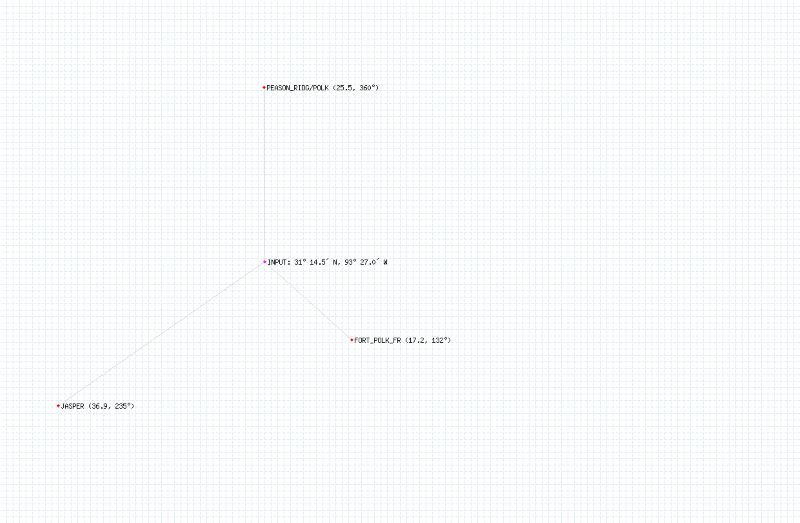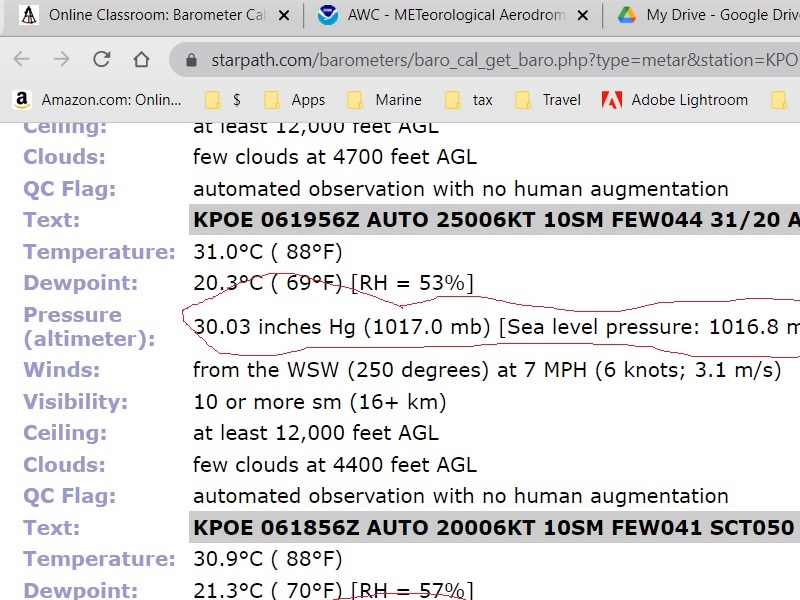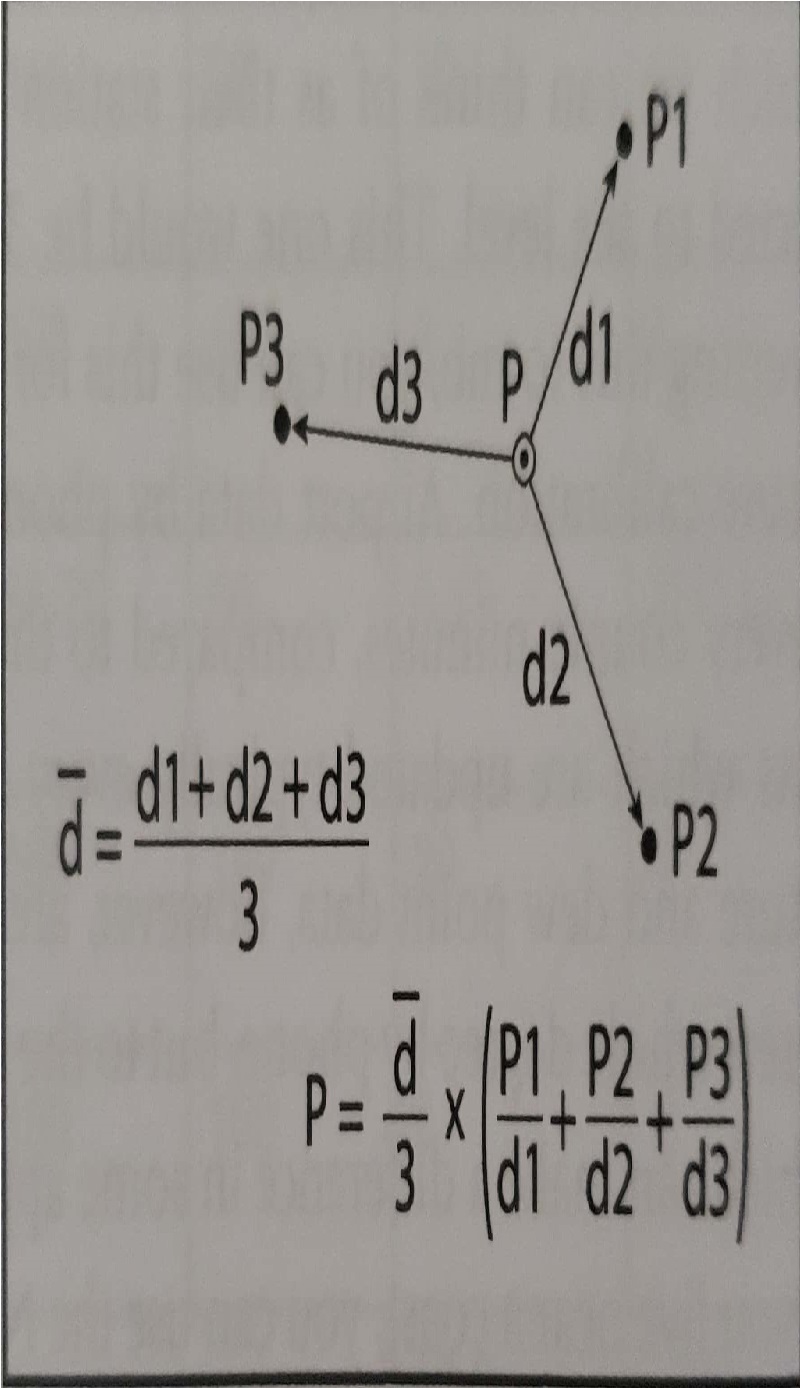|
Author
|
Topic: Barometer Calibration
|
oldman8118
|
 posted September 05, 2022 03:52 PM
posted September 05, 2022 03:52 PM


I am in the process of calibrating a barometer and I have come across 2 questions that I can not seem to figure out on my own.
1. how is it possible to have on a METAR to have SLP that is lower then the pressure altitude for the same station?
2. using the math equation in the Barometer Handbook (p.67) for 3 station points I end up with an answer that doesnt not make sense to me. I have gone thru it couple of times with the answers all ending up the same. The result is around 100 points higher then I would guess by just looking at it. I have provided the plot that I am using for the equation. The additional information need to complete the problem;
P1 = 1013.5 d1 = 25.5
P2 = 1013.8 d2 = 17.2
P3 = 1013.5 d3 = 36.9
The result that I keep getting is 1114.1

|
|
David Burch
|
 posted September 05, 2022 07:39 PM
posted September 05, 2022 07:39 PM


For background, I believe you refer to our service at www.starpath.com/barometers.
To answer both questions, we would need to see all of the data involved.
The first is tied to the average outdoor air temp over past 12h, plus local lapse rate... We need to see all the data related in the unusual case you cite. To interpret the metar you see, you have to go back and also get the data from 12h earlier. Maybe this will do it: https://www.weather.gov/tsa/obs
or check the Starpath Weather Trainer Archives Atlas
The second one must be related to the time averages of the pressure. The procedure we present finds a common time between the three stations and uses the pressures at that time. In other words we are not using just 3 pressures at one time (since the times are likely to be different), we are using 6 pressures at 6 times, then finding a common time and interpolating all the stations to that time.
So if you have all the data related to both questions you can zip it up and send to us for a closer look... but those are the reasons you may see what you saw.
From: Starpath, Seattle, WA
|
|
oldman8118
|
 posted September 06, 2022 05:56 PM
posted September 06, 2022 05:56 PM


This image is from the starpath link to metars. I am a bit confused because the SLP show less then the pressure altitudes.

|
|
oldman8118
|
 posted September 06, 2022 06:06 PM
posted September 06, 2022 06:06 PM


Concerning Q2
I understand the idea behind the time correction. This has to do with the equation that is provided in the book as shown in the attached image. the data for the equation is in the first post (pressure and distance of location 1-3). It is possible that i am doing the work wrong but as I see the 3 location average equation is giving me an answer much greater the all of the 3 pressures. indicating to me that the answer is incorrect.

|
|
David Burch
|
 posted September 06, 2022 08:35 PM
posted September 06, 2022 08:35 PM


Regarding the metar post above: we also need to see the one that is 12h earlier than that one.
On the fitting equations: we need to see all 6 times and all 6 pressures you used to find the P values in the equation.
In other words, you have t11 p11, t12 p12, and t21 p21, t22 p22, and t31 p31, t32 p32.
then we find a tx that is common to the range of all 3 stations, then using that time we interpolate p1-p2 for time tx, and likewise for the other two stations. then we can apply the equations to these final 3 pressures which will correspond to a common time.
From: Starpath, Seattle, WA
|
|
oldman8118
|
 posted September 08, 2022 06:04 PM
posted September 08, 2022 06:04 PM


None of the informtion that you provided is adding any from of clarification to my original questions.
1. METAR - a column of air is heavist at the bottom, not part way up at pressure altitude.
2. I understand the finding of interpolated time. The equation as no variable for time (T), just pressure and distance away from current location, so it is not important in solving for P. Assume the numbers I provided are accounting for time. As I stated before after running the equation numerous times i ended up with a value larger then all the 3 pressures that were used in the equation. That was a red flag to me! Again, regading my question, Time does not matter.
|
|
David Burch
|
 posted September 08, 2022 08:34 PM
posted September 08, 2022 08:34 PM


The equations have no variable for t, but the 3 fixed values you use must be derived from time dependent data.
There is a set of instructions that include a detailed example.
If you will please post the equivalent to the middle table of page 2 for your data in question, then we can fill out the third table and from that we might learn more.
If your position is as shown then you are well positioned to get an accurate pressure... keeping in mind that one of the stations might be in error. We have an article in the blog about how to check the dependability of an airports data.
See http://davidburchnavigation.blogspot.com/2016/01/the-remarkable-gladstone-family-service.html
PS.. i am using our own online computation (starpath.com/barometers). I have not checked the formula you quote. Maybe there is a mistake in that?
Actually... i just see now that you quote where that comes from in your original post. Did you check the errata to that book at
https://www.starpath.com/barobook/. This is linked from the support page of the barometer book page on our site. That may be the whole issue you are raising?
On the other point: Still need the air temp 12 hr earlier to get the conversion right. That should be explained in the book. We also have an article that proves this small detail is crucial:
http://davidburchnavigation.blogspot.com/2013/10/air-temperature-dependence-of-sea-level.html
From: Starpath, Seattle, WA
|
|
oldman8118
|
 posted September 10, 2022 06:20 PM
posted September 10, 2022 06:20 PM


Thanks
|
|
|









